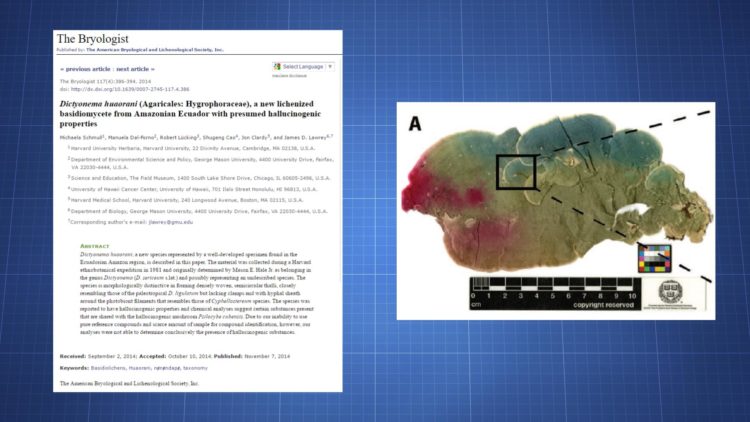Abstract: A lichen growing in Ecuador, Dictyonema huaorani, might produce psychoactive drugs. Among those substances are 5-MeO-DMT and psilocybin (4-PO-DMT). Their presence is not yet definitive, but there is good reason to investigate further.
Authors: Michaela Schmull, Manuela Dal-Forno, Robert Lücking, Shugeng Cao, Jon Clardy, and James D. Lawrey
DOI: 10.1639/0007-2745-117.4.386
Link: http://www.bioone.org/doi/full/10.1639/0007-2745-117.4.386
Published: November 7, 2014
Contents
Introduction
Fungi from around the world have been found to produce psychoactive drugs. Amanita, Claviceps, Psilocybe, Conocybe, and Panaeolus are examples of genera containing psychoactive drug-producing species.
Only a few lichen have been mentioned as producing drugs and the information about them isn’t substantial. Reports throughout history have claimed the following lichen offer hallucinogenic or stimulant effects:
- Parmelia saxatilis
- Parmotrema andinum
- Ramalina siliquosa
- Xanthoparmelia conspersa
Together, those lichen grow in North America, the Shetland Islands, and Mauritania. They’ve supposedly been taken alone or with tobacco. We don’t have much information to go on when examining their potential effects and pharmacology.
Background
Most of the information we have about the lichen now known as Dictyonema huaorani comes from a 1983 paper, “Novel hallucinogens from Eastern Ecuador.” It was written by Wade Davis, a well-known anthropologist/ethnobotanist, and James Yost, an anthropologist who was based in Ecuador for a decade. Yost has been particularly focused on the Waorani (Huaorani) tribe.
Huaorani people live in the Napo, Orellana, and Pastaza provinces of eastern Ecuador. Davis & Yost claimed the tribe contained 600 people in the 1980s. You can see Yost’s pictures of the Huaorani here.
The paper explored how the tribe uses two “hallucinogens,” Banisteriopsis muricata and an unnamed lichen.
Hallucinogen use is “an aggressive anti-social act” in their culture.
[The shaman] who desires to project a curse takes the drug alone or accompanied only by his wise at night in the secrecy of the forest or in an isolated house. – Davis & Yost
When the lichen, which is known by the Huaorani as “nenendape,” was studied by the Smithsonian Institute’s Dr. Mason Hale, it was determined to likely be a new Dictyonema species. The nenendape name is also used for other fungi and lichen.
Just one example of the lichen being used was described in the paper. The tribe said it was used ~80 years prior (around 1900) by a “bad shaman” who “ate it to send a curse to cause other Waorani to die.” It was taken orally, leading to a headache and confusion.
There was also mention of the species being given to children to cause sterility.
It was difficult for the authors to collect a sample and it appears the lichen is considered a rarity by the Huaorani.
In 1996, ethnobotanist Jonathan Ott speculated the unnamed lichen may have also been used in rituals by people in the Peruvian Yurimagua region.
Findings
A 1981 sample collected by David & Yost was further analyzed with the goal of verifying its status as a distinct species and finding its active drugs.
Liquid chromatography-mass spectrometry (LC-MS) techniques were used to look at an extract from 13.6 mg of D. huaorani. Preliminary LC analysis yielded tryptamine and more refined MS analysis yielded possible results for tryptamine, 5-MeO-DMT, and psilocybin (4-PO-DMT).
Another LC-MS analysis showed the “likely” presence of 5-MeO-DMT, 5-MT, and 5-MeO-NMT.
The results are encouraging, though two primary limitations exist. First, only a small amount of decades-old material was available. Second, no authentic samples for the detected drugs were available, only database values. With the limitations in mind, the results were considered tentative by the authors.
Summary
A few lichens have been described as psychoactive throughout history. Unlike with a number of fungal species, there’s not as much evidence for most of the lichen actually containing psychoactive drugs. One of the few that’s been examined with the intention of finding potential psychedelics is Dictyonema huaorani.
Using a couple techniques, 5-MeO-DMT and psilocybin were potentially identified in the lichen. Further research must be done to confirm their presence, though the rarity of D. huaorani stands in the way of research.









